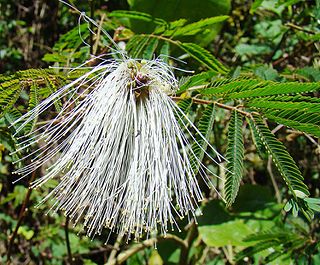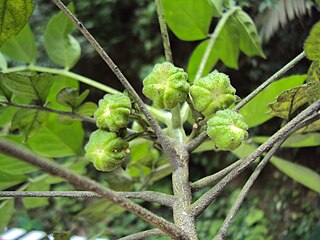Annesijoa is a monotypic genus of plants in the family Euphorbiaceae. The sole species, Annesijoa novoguineensis is endemic to New Guinea.
Bullockia is a genus of flowering plants in the family Rubiaceae. It was originally described as a subgenus of Canthium. The genus is distributed in eastern and southern Africa from Ethiopia to Transvaal, as well as Madagascar in bushland, woodland, savannas, and dry, deciduous forests.

Graderia is a genus of plants in the family Orobanchaceae, which is native to Africa and Socotra. It belongs to the tribe Buchnereae. It is a hemiparasitic taxon.

Bellardia trixago is a species of flowering plant in the family Orobanchaceae. The only member of the monotypic genus Bellardia, it is known as trixago bartsia or Mediterranean lineseed. This plant is native to the Mediterranean Basin, but it is known in other places with similar climates, such as California and parts of Chile, where it is an introduced species and noxious weed.
Capelio is a genus of flowering plant in the Asteraceae first described as a genus in 1836 with the name Alciope. It was renamed Capelio in 2002 after it was determined that the name Alciope was not legitimately published according to international nomenclatural rules. Capelio is a taxonomic anagram derived from the former name Alciope.

Hydnora is a group of parasitic plants described as a genus in 1775. It is native to Africa, Madagascar, and the Arabian Peninsula. Hydnora pollinates through brood-site mimicry. This is a method of pollination in which the plant emits a smell that is attractive to insects, so that the plant can trap the insect and allow it to take pollen so that it can pollinate other Hydnora.

Balizia is a genus of flowering plants in the family Fabaceae. It belongs to the mimosoid clade of the subfamily Caesalpinioideae.

Rhynchocorys is a small genus of flowering plants belonging to the family Orobanchaceae, formerly classified in the family Scrophulariaceae. It is native to Europe, Morocco and Algeria.
Bartsiella is a monotypic genus of flowering plants, initially classified in Scrophulariaceae, and now within the broomrape family Orobanchaceae. It contains a unique species, Bartsiella rameauana.

Crossopetalum, commonly known as Christmas-berries or maiden berries, is a genus of flowering plants in the family Celastraceae. It comprises about 30-40 species.
Kailarsenia is a genus of flowering plants in the tribe Gardenieae of the family Rubiaceae. Its native range is Indo-China to West Malesia.

Larsenaikia is a genus of flowering plants in the tribe Gardenieae of the family Rubiaceae. Its native range is Eastern and Northern Australia.

Manekia is a genus of flowering plants in the family Piperaceae.

Munronia is a genus of flowering plants in the family Meliaceae. Its native distribution is tropical and subtropical Asia.

Swinglea is a monotypic genus of flowering plants belonging to the family Rutaceae. It only contains a single species, Swinglea glutinosa.
Tammsia is a monotypic genus of flowering plant belonging to the family Rubiaceae. It only contains one known species, Tammsia anomala.
Shaferocharis is a genus of flowering plants belonging to the family Rubiaceae.
Oldfeltia is a genus of flowering plants belonging to the family Asteraceae. It contains only one known species, Oldfeltia polyphlebia.
Neonelsonia is a monotypic genus of flowering plants belonging to the family Apiaceae. It just contains one species, Neonelsonia acuminata, native to southern Mexico, Colombia, Costa Rica, Ecuador, Guatemala, Panamá, Peru and Venezuela. It is part of the tribe Selineae.
Kerriothyrsus is a monotypic genus of flowering plants belonging to the family Melastomataceae. The only species is Kerriothyrsus tetrandrus(Nayar) C.Hansen









